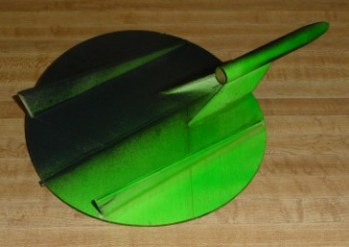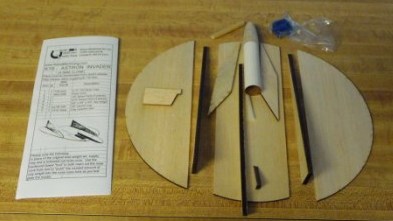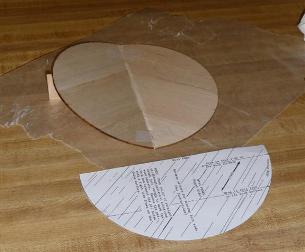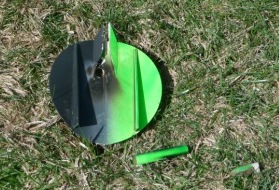Balsa Machining Service Astron Invader (Clone of the Month)
Balsa Machining Service - Astron Invader {Kit}
Contributed by Dick Stafford
| Construction Rating: | starstarstarstar_borderstar_border |
| Flight Rating: | starstar_borderstar_borderstar_borderstar_border |
| Overall Rating: | starstar_borderstar_borderstar_borderstar_border |
| Published: | 2010-03-27 |
| Manufacturer: | Balsa Machining Service  |

Brief:
I won this kit in EMRR's end-of-2009 Quarterly Rocket Give-Away, so I'll first give a hat tip to
Nick. {TIP}
This clone of the Estes K-19 Astron Invader is a odd-roc glider that has been described as a Flying Pie
Plate. Its flight profile has been questionable, so Of Death belongs in the nickname too. So, that's what
I'll call mine. After reading the reviews and given my history with gliders, I suspect mine will fly exactly once.
Construction:
The kit included the following parts:
- 18mm body/motor tube
- Balsa nose cone, pre-drilled for nose weight
- Laser cut 1/8" motor pylons, rudders and bottom skid
- Laser cut, 3-part, 3/16" wing panel components
- Laser cut stand/brace to set the wing dihedral
- Launch lug
- Clay nose weight with dowel for tamping

 Construction starts by assembling the 3-part 'pie-plate' wing panel. I laid the parts on some wax paper
and used white glue. I placed a container of coffee on to to hold the parts down while the glue set. Next, I printed
the templates from the instructions downloaded from JimZ. I found that I had to disable 'fit to page' and then set the
scaling factor on my printer to 101%. You use the template to mark locations for the pylons and rudders as well as the
mid-line of the circle. You then cut the assembly in half. One half is flipped over, which alternates the grain pattern
and adds some strength. The two parts are rejoined with a dihedral applied using the provided brace.
Construction starts by assembling the 3-part 'pie-plate' wing panel. I laid the parts on some wax paper
and used white glue. I placed a container of coffee on to to hold the parts down while the glue set. Next, I printed
the templates from the instructions downloaded from JimZ. I found that I had to disable 'fit to page' and then set the
scaling factor on my printer to 101%. You use the template to mark locations for the pylons and rudders as well as the
mid-line of the circle. You then cut the assembly in half. One half is flipped over, which alternates the grain pattern
and adds some strength. The two parts are rejoined with a dihedral applied using the provided brace.
I didn't see what to do with the balsa edges either in the instructions or the existing reviews. I asked the previous reviewer (Chan) and he suggest to just sand the edge off, not even fully rounding the components. It seems wing lift can and does cause this rocket to loop under power and I assume tapering the wing tips would aggravate this effect.
There is a marking guide for the position of the two motor pylons on the motor pod. After the pylons are attached, you sand the root edges, as a single assembly, to mate with the wing dihedral. I saw on YORF that some people mentioned angling the nose down a couple of degrees to counter wing lift and I decided to to so. A quick calculation showed that sanding about 1/16" off of front end of the roots would provide about 2 degrees (tapered to the rear end).
The root edges of the rudders are also sanded to better mate with the dihedral on the wing. These are then attached along the marked lines. The final steps prior to glide trimming is to attach the skid and the launch lug.
Nose weight is added as required by ramming clay into the pre-drilled nose using the provided dowel. I got overly rambunctious on this step and the cone split. I little white glue fixed this minor snafu. I found I still needed more weight. Rather than add it to the cone, I extended the motor pod by a couple of inches.
On the first glide test, it went a good distance and then seemed to stall a bit. The next time, it nose dived quickly. A couple of times it seemed to glide after flipping over. I tossed it parallel to the ground, right side up and inverted and even chunked it in the air as high as I could. Finally, I went onto the deck and threw it out at about a 45 degree upward angle over the drop off into our lower yard. I stayed upright, pulled a wide 180, and dinged its wing on the chicken wire that keeps our dog our dog. Good enough for me!
Finishing:
Like on most gliders, you don't want to add weight by filling the grain and adding a bunch of
layers of primer and paint. I sanded the finish product with some fine sandpaper and then used Rustoleum flat black and
day-glo green.
Construction Rating: 3 out of 5

Flight:
This glider is meant to spit the motor so you don't really even need to friction fit it. I
decided to try an A8-3 since that is the only recommended motor that I had on hand. Well, it arced right over and lawn
darted. It's dead but I saved the motor pod.
Flight Rating: 1 out of 5
Summary:
This is a weird odd-roc glider that I think looks cool. Unfortunately, mine was unstable on
boost. As I projected at the start, it only logged one flight. It's certainly possible that this was due to builder
error. But if I made an error and have no idea where it was, I'll still give it a low rating.
Overall Rating: 1 out of 5
Other Reviews
- Balsa Machining Service Astron Invader (Clone of the Month) By Chan Stevens (August 23, 2008)
Best described as a flying pie plate, this is another in the BMS clone of the month program offerings. This particular kit is a clone of the K-19 Astron Invader, introduced in the 1966 Estes catalog, making the original only a year younger than this modeler. Designed to be a spit-motor glider, it's a very finicky design but worth the effort for a decent glide. There is a bit of ...
Sponsored Ads
 |
 |










